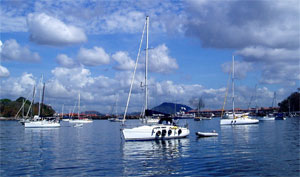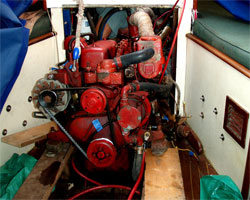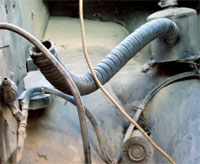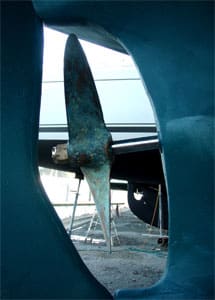Many sailors describe voyaging as “fixing boats in exotic places.” More often than we’d like to admit, this is accurate. Some repairs are fairly easily accomplished even in an uninhabited cove in Vanuatu, provided you carry your supplies with you, and others are impossible or next to impossible. But that “next to” is the crux of the matter.
Pulling a propeller shaft, for example, is a delicate operation best performed by an experienced mechanic on the hard in a boatyard. On a long voyage, however, one doesn’t always find a convenient or affordable boatyard. Suddenly, an impossible repair becomes next to impossible.
When my husband Seth and I set out on our global circumnavigation, we had just completed an extensive refit of our 1968-built cutter-rigged sloop Heretic. Unbeknownst to us, however, and unrevealed by our survey, our 40-year-old Perkins 4.107 diesel engine was sitting on rotten bed logs. It wasn’t until our propeller stopped turning in the Panama Canal that we appreciated just how grave our situation was. The aft engine mounts had sunk into the bed logs, so the engine had come out of alignment and sheared the bronze key between the coupler and the shaft. The old Perkerbeke — the Perkins had been marinized by Westerbeke — still hammered away, but the propeller lay inert and useless.
 |
|
Ellen Massey Leonard |
|
The harbor at Isla Flamenco, Panama, where Ellen and Seth Leonard worked on their sloop Heretic. |
After a week sweltering in the jungle of Gatun Lake, Heretic received a tow to the Pacific. A haul-out in Panama City was not in our budget, so we decided that this extensive repair was not impossible, but only next to impossible. We set to work at anchor in the outer harbor, protected by Isla Flamenco. It was not an ideal location: in 30 feet of murky brown water, retrieval of any lost items was out of the question. But Flamenco was preferable to Balboa, which was constantly rocked by the wakes of ships and pilot boats exiting the canal.
A borrowed prop puller
To remove the propeller shaft, we had to take off the propeller itself. This entailed several steps. First Seth borrowed a prop puller from a friendly neighboring voyager. The tool works by hooking onto the forward end of the propeller and applying pressure to the aft end of the shaft, thus pulling the prop aft. When the propeller is freed, everything can come off all at once. Because it is possible to drop the puller and/or the prop, the project is better done in a shallow, clear anchorage where one can recover items from the bottom. We didn’t have this option, however, so we tied a line to the puller and to a stanchion on Heretic to prevent loss. Bracing himself against the propeller to keep the shaft from turning, Seth backed off the forward prop nut (there were two on the original shaft) only part way so that if the propeller popped off, it would remain on the shaft. Finally, he oriented the propeller so that its key was facing up. Thus we prevented the possibility of losing the prop puller, the propeller, the prop nuts, and the key. Then he removed the propeller and its assorted items. A scuba kit or hookah dive system would greatly facilitate the process as they allow you as much time as you need at such a shallow depth. It is important to be trained in scuba before attempting to use that type of equipment.
With the propeller safely on deck, we turned to the shaft. In our case, it was already out of the coupler: its key had been sheared and its forward end had been mashed by the force of the misalignment. Therefore it was possible for us to remove the shaft from outside the boat. Normally, the shaft would be extremely difficult to separate from its coupler. Boatyards employ a special tool for this purpose. If you need to remove a prop shaft that has not been damaged in the way ours was, it is much better to do so from inside the boat and thus keep the coupler and shaft attached. This requires moving the engine, or just the transmission if that provides enough space.
However the shaft is removed, its absence creates a hole an inch or so wide below the waterline, a hole capable of sinking a yacht within minutes. We prepared a wooden cone plug of the sort that all sailors should keep ready to stop up a broken seacock. I inserted a wood screw into the tapered end of the cone, and then made a stout and slender piece of line fast to the screw. When Seth, diving under Heretic’s stern, pulled out the shaft, he let the first gush of water guide this line in. Then he jammed the cone into the hole, and I yanked on the line to make it fit snugly. There was only a tiny trickle until the wood swelled and sealed the hole completely.
 |
|
Seth Leonard |
|
Heretic’s engine being moved forward using the main halyard. |
 |
|
Seth Leonard |
|
The prop shaft and coupler were installed from the inside. A plug was used to prevent flooding while the shaft was removed. |
A local machine shop
Our next step was to take the shaft to a machine shop to be repaired. Panama does not lack yachting facilities, but they charge a premium, so we settled on a more general machine shop in the city. Remote locations usually lack yacht services, but just about anywhere with a town will have a machine shop capable of this kind of work. Seth and I later had our Hurth transmission rebuilt on the Cocos (Keeling) atoll, 2,000 nautical miles from anywhere in the middle of the Indian Ocean. The machinist did have to order parts from Australia, but his workmanship could not have been bested by any boatyard.
The fit between the shaft and coupler has to be exact, so they are best attached by the machinist. Therefore the engine, or at least the transmission, must be moved to insert the shaft from inside. Aboard Heretic, while our shaft was being machined, Seth and I moved our Perkerbeke forward into the cabin using a block and tackle system with our main halyard. We also repaired the bed logs. We had plenty of room to reinstall the shaft from inside, so all that remained was to coordinate with the person outside the boat, diving under the stern. Seth pulled out the wooden plug and I put in the new prop shaft. The last step was to reaffix the propeller, making sure not to lose the key, and to refasten the prop nuts.
We moved the Perkerbeke and its transmission aft again with our block and tackle system, and aligned it to its very exact tolerance with the coupler, measuring with feeler gauges. This was the only moment at which we hired a mechanic to help us and to teach us the process.
In a final analysis, we had learned that bed logs must be fully encased in fiberglass and epoxy. Ours hadn’t been, which had allowed water to seep in under the mounts and produce rot. Regardless of your survey, it is always important to check your engine’s bed logs and mounts yourself. Our mechanic also showed us the benefits of a flexible coupler, which can reduce wear and prevent problems. Even with a flexible coupler, however, the tolerance for alignment is only 0.01 of an inch.
A year and 7,000 sea miles later, in New Zealand, Seth and I decided to upgrade to a newer Yanmar diesel. To make it easier on ourselves, we installed it ashore on the hard at the same time Heretic was due for antifouling. With the knowledge and confidence we had gained in Panama, we completed the entire installation ourselves. The full service Kiwi boatyard hardly counted as fixing Heretic in an exotic place, but we had found just how much one can accomplish in remote locations.
Even when faced with limited resources, language barriers, or isolation, it is pleasantly surprising just how few truly impossible repairs there are.
———–
Ellen Massey Leonard is a freelance writer who recently circumnavigated with her husband Seth on board their former boat, Heretic, a 38-foot sloop.

